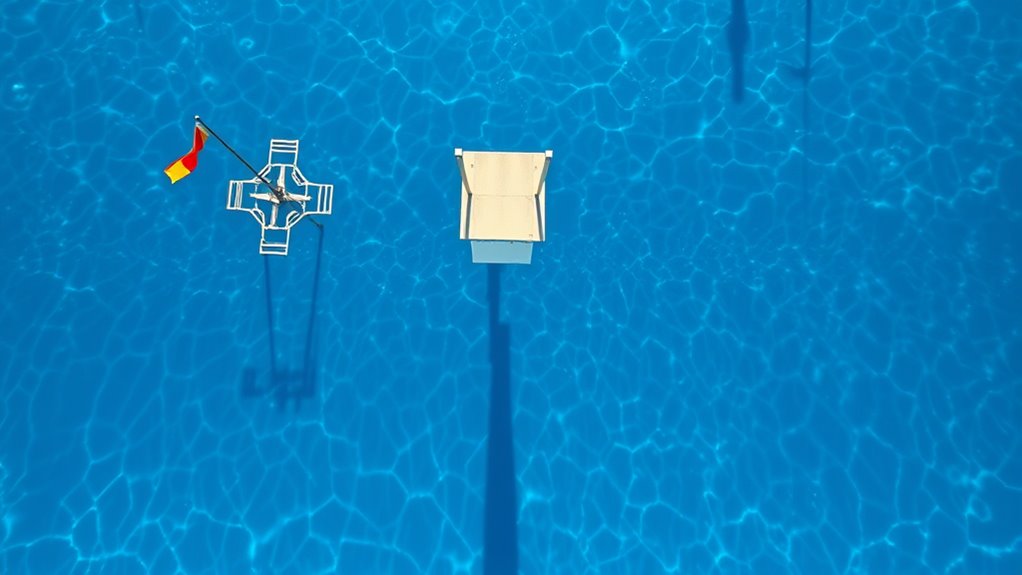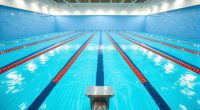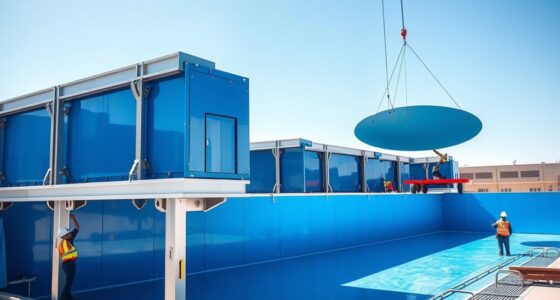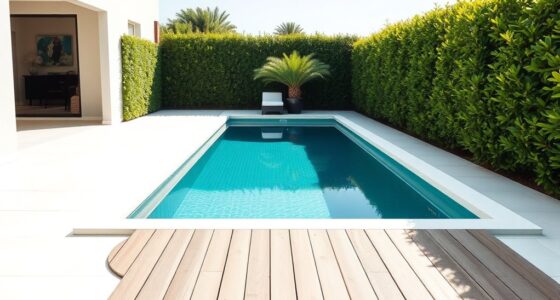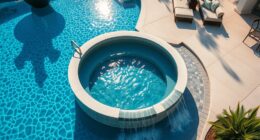When using diving pools, make certain the depth matches your activity—shallow pools (9-12 feet) suit casual dives, while deeper areas (16 feet) are safer for flips and high dives. Board heights typically range from 1 meter to 3 meters, depending on skill level and competition standards. Always follow safety rules like checking the depth, staying in designated zones, and avoiding overcrowding. Continue exploring to learn essential tips that keep you safe and confident in the water.
Key Takeaways
- Ensure pool depth is appropriate: 9-12 feet for basic dives, 12-16+ feet for flips, and at least 16 feet for high dives.
- Use diving boards and platforms that match skill levels: 1 meter for residential, 3 meters for competition, with higher platforms for advanced divers.
- Always verify pool depth and stay within designated diving zones; avoid shallow areas and crowded zones to prevent injuries.
- Follow safety rules: wait for lifeguard signals, avoid running or pushing, and practice controlled diving techniques.
- Maintain proper lighting, signage, and safety equipment to enhance visibility and safety during all diving activities.
Recommended Depths for Different Diving Activities
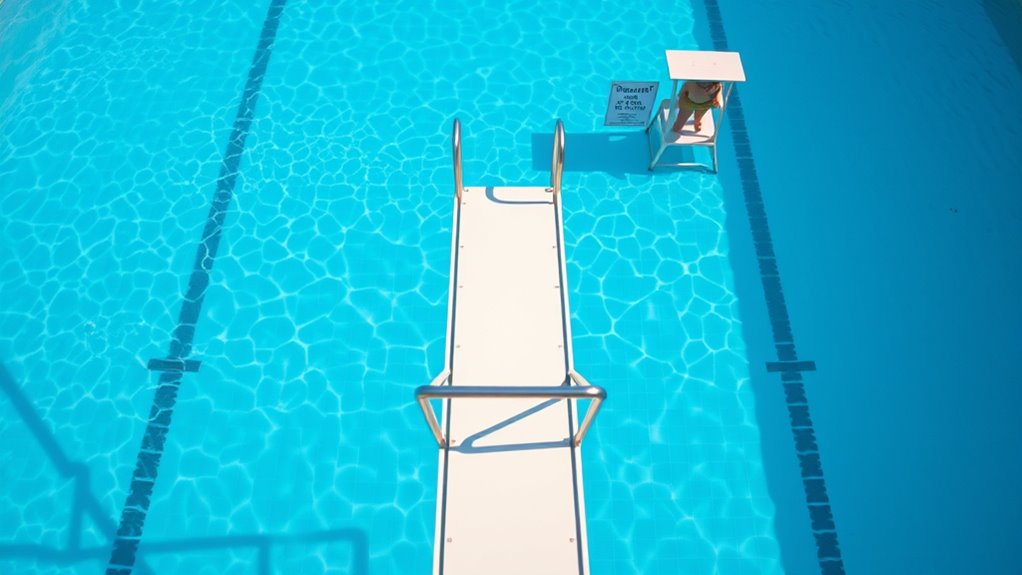
When planning your diving activities, understanding the recommended depths is essential for safety and enjoyment. Different dives require specific depths to prevent injuries. For example, basic recreational dives into shallow pools typically need at least 9 to 12 feet to avoid hitting the bottom too hard. More advanced dives, like somersaults or flips, demand deeper water—usually 12 to 16 feet or more—to give you enough space to complete your movements safely. If you’re practicing high dives or platform dives, depths should reach at least 16 feet, with some facilities going deeper for safety margins. Always follow posted depth guidelines and ensure the pool is equipped with appropriate markings to help you gauge safe diving zones. Proper depth awareness keeps you safe while maximizing your enjoyment. Additionally, understanding the contrast ratio of your pool’s lighting can improve visibility and safety during nighttime dives.
Standard Heights for Diving Boards and Platforms
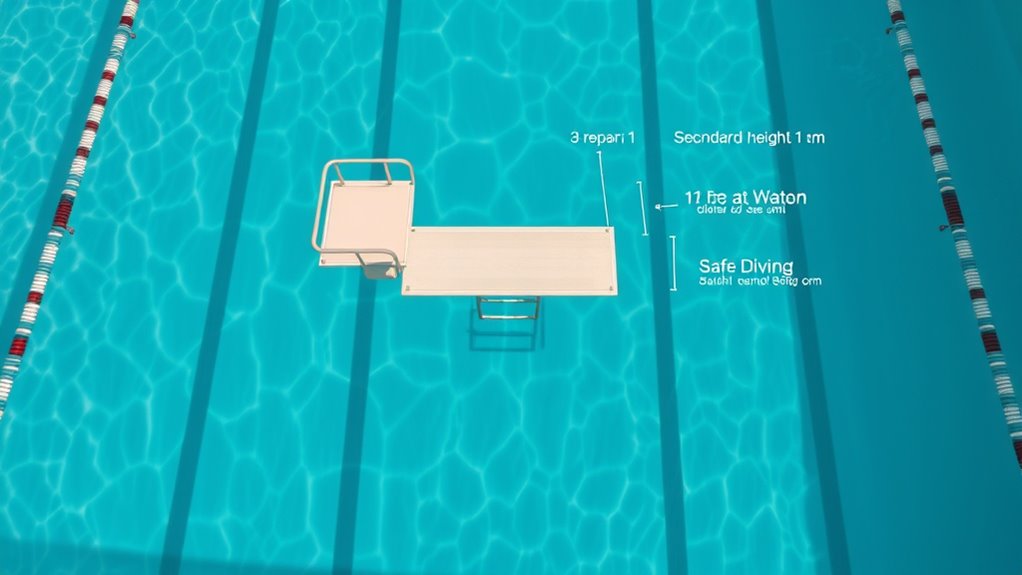
Standard heights for diving boards and platforms are designed to guarantee safety while providing the right challenge for divers of all skill levels. The most common residential diving board height is 1 meter (about 3.3 feet), suitable for beginners and casual swimmers. For more experienced divers, competition-standard boards typically stand at 3 meters (around 10 feet). In public pools, platform heights vary, with 1-meter, 3-meter, and sometimes 5-meter platforms available. Each height offers increasing difficulty and thrill, but safety must always come first. Ascertain your diving pool is equipped with the appropriate board height for your skill level and pool depth. Following these standards helps prevent accidents and ensures a fun, challenging diving experience. Additionally, mammography guidelines emphasize the importance of appropriate safety measures and equipment standards, which can be paralleled to ensuring proper safety protocols in diving activities.
Essential Safety Rules for Diving Pool Use
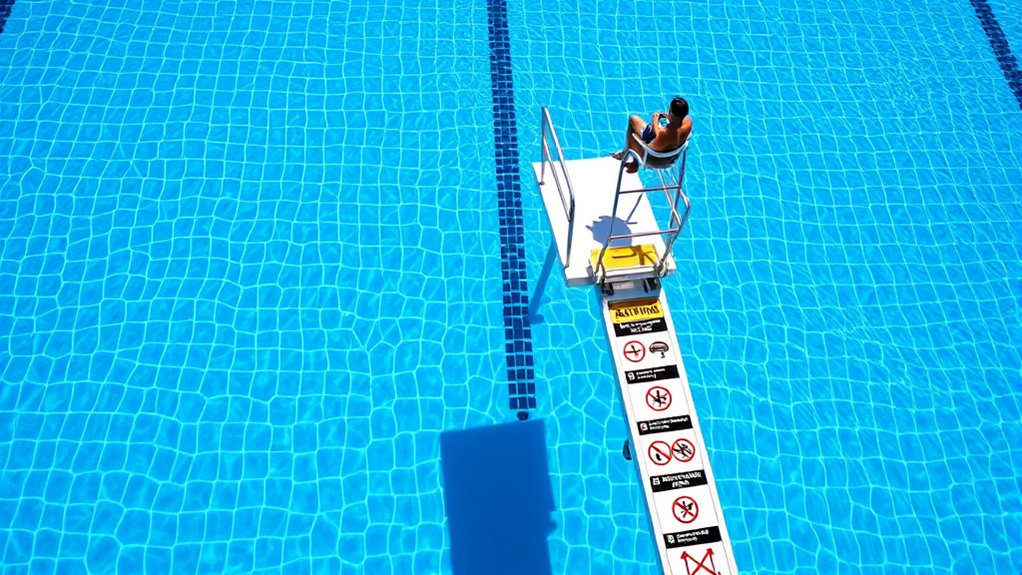
To make certain safety while enjoying diving pools, it’s vital to follow key safety rules that protect all swimmers. Always check the pool’s depth before diving—never jump into shallow water. Use designated diving areas only, avoiding corners and edges. Wait for the clear signal from lifeguards or pool staff before entering the water after a dive. Be mindful of others and avoid overcrowding the diving zone. Never run or push others around the pool deck to prevent accidents. Ensure your diving technique is controlled to avoid injuries. Remember, safety is everyone’s responsibility. Additionally, understanding field recording techniques can help in recognizing the importance of environmental awareness and precise measurements in ensuring safe and quality sound capture.
Frequently Asked Questions
What Are the Consequences of Diving Into Shallow Water?
If you plunge into shallow water, you risk serious injuries like head and neck trauma, spinal cord damage, or broken bones. You could also hit the bottom, causing cuts, bruises, or worse. These injuries can be life-altering or fatal. Always check water depth before diving, follow safety rules, and never assume the water is deep enough. Prioritize safety to prevent these dangerous consequences.
How Often Should Diving Pools Be Inspected for Safety?
You should inspect diving pools at least weekly to guarantee safety. Shockingly, according to the CDC, nearly 80% of diving-related injuries happen in pools that haven’t been properly maintained or inspected. Regular inspections catch hazards like cracks, sharp edges, or uneven surfaces early. By staying vigilant, you prevent accidents and protect swimmers, ensuring everyone can enjoy the pool safely and without worry.
Are There Age Restrictions for Diving Pool Use?
Yes, there are age restrictions for diving pool use. Typically, children under 3 or 4 years old aren’t allowed to dive due to safety concerns. For older kids and teens, restrictions depend on pool rules and supervision levels. Always check with the pool facility’s specific regulations, as they may set age limits for diving to prevent accidents. Remember, following these rules keeps everyone safe.
Can Diving Pools Be Used for Swimming Laps?
Yes, you can use diving pools for swimming laps, but it’s important to verify the pool’s design and rules first. Diving pools are typically deeper, making them suitable for laps if the depth is appropriate. However, ensure you follow safety guidelines, avoid diving in shallow areas, and be mindful of other swimmers. Always confirm with the pool management that lap swimming is allowed and safe in that particular pool.
What Equipment Is Recommended for Beginner Divers?
Starting with the right equipment sets you up for success. As a beginner diver, you’ll want a well-fitting wetsuit or rash guard to stay warm and comfortable. A good pair of fins helps you propel effortlessly, while a lightweight snorkel makes breathing easier. Think of it as gearing up for a smooth journey—just like a pilot needs the right tools to fly safely. These essentials boost your confidence and safety in the water.
Conclusion
Now that you know the essential depths, board heights, and safety rules, you hold the power to dive confidently and safely. Ignoring these guidelines is like risking a plunge into chaos—your safety depends on it! Always respect the rules, double-check pool depths, and stay alert. With proper precautions, you’ll make every dive a splash of fun rather than a splash of disaster. Dive smart, stay safe, and enjoy every moment in the pool!
